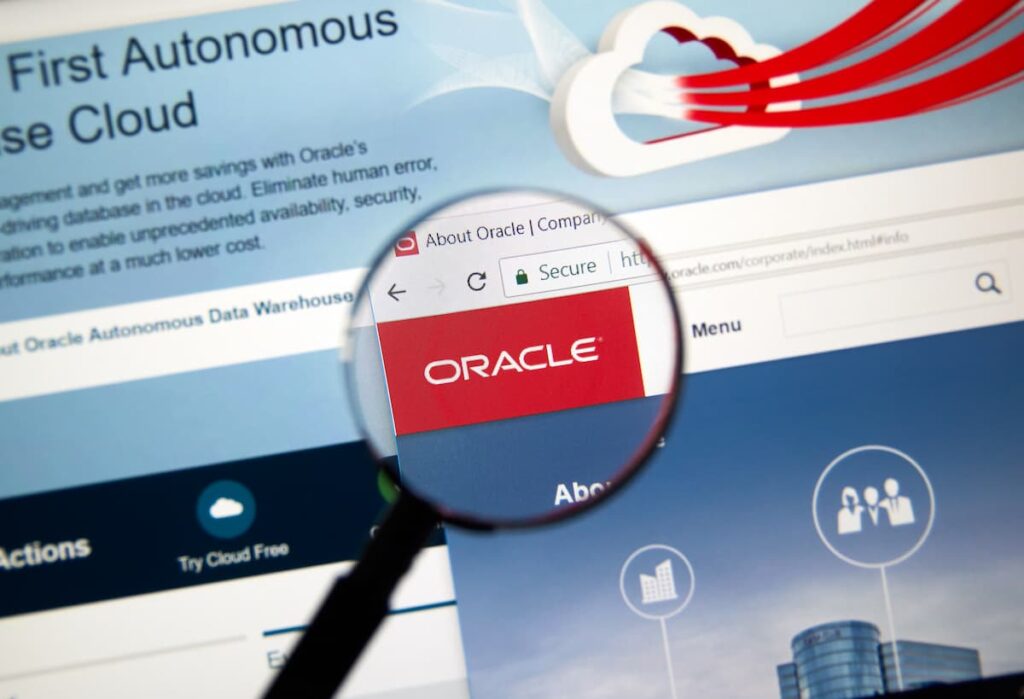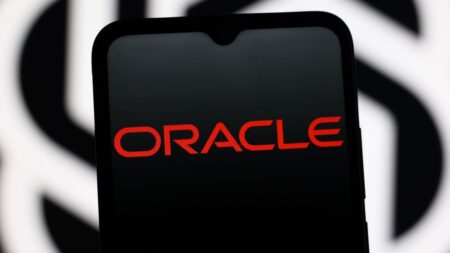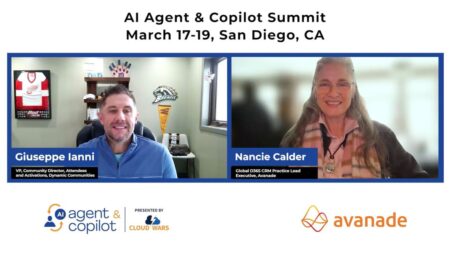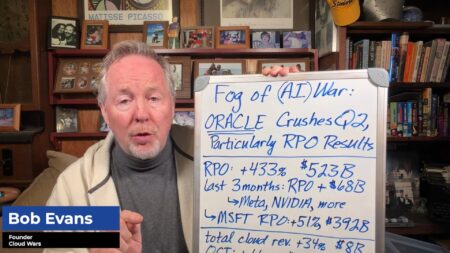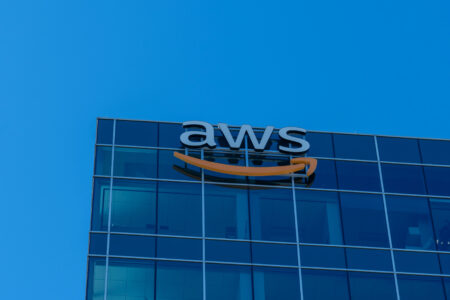
From creating disease-specific treatment models to generating more-relevant sales leads to closing financial books in days instead of weeks, Oracle is accelerating its deployment of AI and ML technologies across its LOB apps, industry-specific apps, and cloud-infrastructure services, according to CTO Larry Ellison and CEO Safra Catz.
Speaking on the company’s recent fiscal Q3 earnings call, both Ellison and Catz repeatedly emphasized Oracle’s accelerating use of AI and ML across its vast product line to deliver compelling outcomes and create entirely new opportunities for Oracle customers.
Now, it’s hardly a surprise to anyone that Oracle — or for that matter any other Cloud Wars Top 10 company — is looking to showcase its work around AI and ML. And I hope you’ll trust all of us at Acceleration Economy and Cloud Wars to go beyond the obvious and focus our analyses on the ways in which those world-changing cloud providers are deploying AI and ML to drive innovation, growth, and productivity for customers.
In that light, while Oracle hasn’t been making any announcements about splashy new consumer-oriented generative AI applications, it has made a number of big advances to help its business customers do things more rapidly, more intelligently, and with better business outcomes. Here’s a quick overview of some of those, and then I’ll share some verbatim comments from both Ellison and Catz.
- Close books in days, not weeks. ML tools within Fusion Cloud ERP automate a huge range of reporting and reconciliation tasks, and the ultimate proof comes from Oracle itself: Its fiscal Q3 ended Feb. 28, and it released full quarterly financial results on March 9.
- More relevant sales leads. Oracle has focused its CX applications on helping salespeople drive more revenue rather than helping managers monitor the performance of salespeople. And the technological lynchpin behind that is Oracle CX’s ability, built on embedded AI, to automate and integrate marketing solutions with sales solutions to surface better leads.
- Automate processes, make customer-aligned recommendations, and offer fresh and data-driven insights. These are the primary objectives of the embedded AI fused into all of Oracle’s applications, both LOB and industry-specific.
- Replace DBAs with AI. That’s what’s happened with Oracle Autonomous Database, and Ellison has spoken of wanting to extend that concept by making the entire Oracle Cloud autonomous to eliminate the possibility of human error.
- Create disease-specific AI models. Oracle’s doing that now with customers and partners around cancer treatment, and will soon extend that to other diseases. (Ellison describes this in detail below.)
- Boost cloud-infrastructure performance and security. AI has been a critical component in Oracle’s surging growth in cloud infrastructure, which I feel is particularly noteworthy given that the competitors it’s going up against are three of the world’s wealthiest and most powerful corporations: Amazon, Microsoft, and Google.
CEO Safra Catz on “Real Enterprise AI”
From the March 9 earnings call, here’s Catz on what she called “real enterprise AI,” which I outlined a week ago in Oracle CEO Catz: Booming Cloud Business Will Grow 50% in Q4:
“While AI has been dominating the recent news cycle, the truth is that our Fusion and infrastructure customers have been using AI as an integral part of their business for some time. Oracle Fusion with embedded AI enables customers to close their books in days, not weeks. Oracle AI provides more relevant sales leads. Oracle AI increases infrastructure performance and security with no human intervention. And customers using OCI get AI as a service to help drive their own business transformation.
“Given our scale and our information advantage across industries and technologies, we are constantly training our applications to do more for our customers, whether it’s further automating processes, providing critical and timely recommendations, offering insight, or flagging potential issues. That’s real Enterprise AI. It’s what customers are looking for. It’s designed into everything we do, and that’s what our customers get when they use our platform. And on our Gen 2OCI platform, the architecture and unique network capability has fast become the platform of choice for many AI companies because OCI runs workloads faster, and time is money in the Cloud.”
Larry Ellison: AI Powering OCI Surge
On the call, one analyst asked Ellison, “With the slowdown we’re seeing across so many IaaS and PaaS vendors for the last couple of quarters and especially this quarter, why has OCI Gen2 held up so well? You have brought in the Cloud customers where you’ve seen weakness elsewhere. Is it simply low price? Is it performance? Is it you’re at the right time in the economic cycle to be capturing new customers? Is there some dynamics around expiry credits that are driving this? The difference is just so stark.” Here’s part of Ellison’s reply.
“Oracle’s Gen2 cloud is quite different than the other hyperscalers. We have a non-blocking RDMA network that is very much faster than the other guys’ networks. What this means is if you want to run a large group of NVIDIA GPUs in a cluster doing a large AI problem at Oracle, we can build those NVIDIA GPU AI clusters and run them. We can build those things dynamically. Because we use our standard network supports the clustering, the large clustering of GPUs and allows them to communicate very quickly. We can marshall them together.
“The other guys can’t do that. They can build clusters, but they actually are physically building new clusters — they’re building new hardware. Our existing hardware and our standard network allows us to group these GPUs together dynamically to attack AI problems. No one else can do that… So a lot of new AI companies are coming to Oracle because we’re the only ones that can run their workloads. And by the way, we’re cheaper — so we’re faster and we’re cheaper…
“We have a partnership in healthcare with MD Anderson Hospital and one of our independent software vendors called Ronin where we build these disease-specific AI models that make recommendations to doctors about care… MD Anderson has actually shown if you use this system, you reduce hospital admissions and readmissions by 30%. That’s a stunning number. People talk about ChatGPT being really cool because it can write my high-school essay for me. Well, how about reducing hospital readmissions at MD Anderson by 30%. You decide which is more important…
“These disease-specific AI models and the telemedicine models that we’re delivering allow a patient in the community hospital in Montana to get the benefits of the wisdom of the best cancer specialists at MD Anderson Hospital in Texas or Memorial Sloan Kettering in New York or Mass General or a doctor at Harvard Medical School.”
The Role of AI in Autonomous Database
Here’s Ellison on how AI has helped create a type of database that no other competitor has been able to match.
“The Oracle Autonomous Database doesn’t have any Database administrators. It’s completely self-driving. The Oracle Autonomous Database is self-driving because it has an AI module that is the DBA. We replaced the DBAs with AI inside of our own cloud… The administrative part of our cloud keeps track of all of our users, our billing, all of those things, recovery data sets, all of that stuff is now done using AI and our Autonomous Database. So we’re a huge consumer of AI, and we’re a huge vendor of AI GPU capacity and cluster capacity.”
Ellison on AI Supply and Demand
“There’s actually more demand for AI processing than there is available capacity… We are expanding as fast as we can. It’s really interesting and it’s an exciting opportunity, but it’s also challenging when there’s more demand than supply. The difference with us is our standard network allows us to group together these GPUs and have them attack these problems, whether it’s a medical diagnostic problem or it’s a generative language problem…
“So we have a lot of ISVs seeking us out because not only do we have the most cost-effective solution, but we can also make the solution available to them very quickly because it runs on our standard network.”
To hear more data modernization, AI/hyperautomation, cybersecurity, and growth strategies from CIO practitioners, tune into Acceleration Economy’s Digital CIO Summit, which takes place April 4-6. Register for the free event here.


